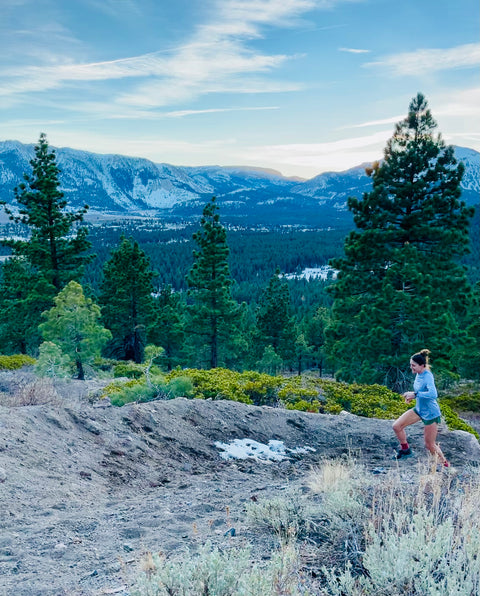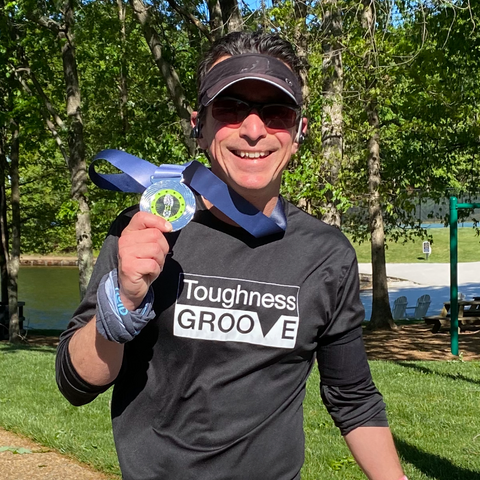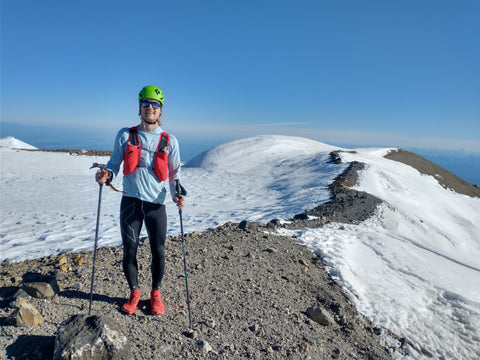Congrats on making the jump into the world of ultrarunning! It’s going to be a wild ride–and you are giving yourself a gift that will awaken endless possibilities. Let's do this!
1) Know Your Intent. Ultrarunning is any distance over 26.2 miles (50k, 50mi, 100k, 100+mi) and usually on trails.There are countless reasons why people run ultras. Dig deep to find yours. Is it to get into shape? To explore the backcountry? Challenge yourself to new heights? Find new friends? Start with your goals and then write down some bucket list races (www.ultrasignup.com is a good place to start).
2) Start Slow. For races, I recommend starting at the 50k distance and then increasing distance as desired over time. Of course, this all depends on your running background. The slow increase will help in adapting gradually to the aerobic and musculoskeletal stress of ultras. But it isn’t only to build muscles, tendons, and ligaments to sustain the distance. It takes time to learn how to pace yourself and to prepare yourself for the ultra mindset. Don’t rush the process–enjoy the journey!
3) Seek a Trail Running Community. Whether you are toeing the line for the first time or an experienced, elite trailrunner, we are all a part of the same trail family! Start by “Strava stalking” and reach out to others to run, or connect with others at your local running store. Volunteering at a local ultra is a great way to meet other trailrunners. We really are a friendly bunch! We thrive on big adventures in the mountains and showing new trail runners the ropes. Lean in for support and help with discovering trails. Friends make training more exciting.
4) It’s a Family Affair. If your partner or spouse isn't supportive of you training for an ultra, your dreams of getting to the event in a happy state of mind may be short lived. Start with open communication to address concerns. Training for an ultra takes time–set expectations. Plan in advance when you can run during your family reunion weekend. Try involving them in planning for your first race as crew at Aid Stations. Get the kids involved with planning your routes online or paper maps, and get them out for a hike after your run. The earlier you can expose your kids to the great outdoors the better!
5) Be a Sponge. Stay humble! There are decades upon decades of “dos and don’ts'' and knowledge in your local trail running community. Ask the questions and listen! I highly suggest trail running podcasts, books, or magazines (DM me for my favorites!) to soak up all the knowledge you can. My caveat to this: every ultrarunner is going to have tips and tricks; try them out for yourself and see what works for you! Pickle juice never sounds good to me in an ultra, but some people swear by it! :)
6) Get a Coach. I can’t emphasize this enough. Having an objective insight into your training is priceless. Coaches can teach you how to manage training loads–when to push and when to back off. It's critical to be open and honest with how you are feeling emotionally, mentally, and physically. Your coach should know about every niggle and every big stressor.
7) Consistency is Key. If running is a scheduled part of your day, it will happen. Set yourself up for success! Bring your running clothes to work so you can hit the trails after. Lay out your favorite running clothes, shoes, and fuel/hydration (packed and ready to go) the night before. I always set a timer on the coffee pot. Running with friends helps with accountability, especially initially. It's about progress, not perfection. As the saying goes, don’t try and be consistently great, try and be great at being consistent! In training, there will be days that you aren't feeling your best. Acknowledge it. And when you are feeling good, USE IT! Make the good days count by seeking out a challenging hilly route or using that extra energy to practice downhill technical running.
8) Fuel and Hydrate. I always joke that whoever fuels the best wins–and this is truly from experience! I don’t believe in a “race weight”–focus on getting strong! Fueling on race day is a huge part of success in an ultra. Fuel and hydrate EARLY, both in training and racing. I train how I race so that my gut is accustomed to taking in fuel when running. I aim for 200-300 calories per hour, including calories from hydration (e.g. there 100 calories in 1 scoop of Fluid Performance). If you want longevity in the sport, you need to eat, and I mean a lot. Carbs for fuel are your friend and protein is crucial. I aim for 100grams of protein daily (my favorite source is Fluid Spiced Vanilla). We also know hydration status is a predictor of race performance–use this to your advantage! I aim to drink 12 to 16 ounces of Fluid per hour in training, but I usually drink 20-30oz when racing with increased intensity (and more if it's hot or at altitude!).
9) Fuel the Stoke. Fueling isn't just food and hydration–it’s about staying engaged in your training. Seek out new trails. Plan a big adventure with friends. Race in places that excite you!
10) Practice the Ultra Mindset. Grit, perseverance, flexibility, having a positive outlook at all times… these are core attributes to all trail runners. If you are looking for overnight success, this is the wrong sport! The “success” is in the life lessons you learn from pushing yourself to your greatest potential.
11) Race-Specific Training. If you will be racing in the heat, practice staying cool while running. Racing on technical trails or big vert? Practice on your training runs! Tips for racing in heat: I use my hydration pack with softies for Fluid Performance and then a separate handheld of ice water just to douse my hat and my core while running. I also use an ice bandana around my neck and put loads of ice in my sports bra. Tips for training for a technical race: I seek out the most technical line to run in training. In races, of course, I find the easiest line. “Finding a line” when running technical trails comes with experience–and you don't want to learn while racing! Challenge yourself in training so the race is easier.
12) Run with Trail-Specific Shoes. Choose shoes that are specific to the trail and your chances of injury decrease and chances of happiness greatly increase! If the trail is technical and muddy, choose a shoe with big lugs (such as Saucony’s Peregrine 11). Fast fire road or buttery trail? Go with a more versatile trail shoe (my favorite is the Saucony’s Canyon TR).
13) Stay Safe. This has been on the forefront of our minds since the devastating incident in China when 21 ultrarunners died of hypothermia. This event shook the global trail community deeply. Safety measures are critical in the backcountry, especially at higher elevations, when temperatures can change quickly and storms can roll in unexpectedly. Bring a lightweight rain/wind jacket, gloves, and an emergency blanket in your hydration pack. It's worth a bit of extra weight–it could save your life. Unexpected delays can happen on trail adventures. Bring more water and fuel than you think you need and tuck away a light headlamp. Plan your route in advance and share with loved ones. Satellite phones can save your life in the case of an emergency in an area with no cell phone service. Hitting the trails with at least one other person, especially in remote locations, is always a good idea. Remember, wildlife may be around; we are playing in their territory, so always be respectful and stay calm. Do not try to outrun wildlife; instead, back away slowly. Be familiar with animals that live in the area you are running and act accordingly (https://www.velopress.com/wildlife-animal-safety-trail-runners/ is a good resource for dos and don'ts).
14) Use the Long Run. The long run isn't just about “time on feet.” It's about learning what fuel works best for you, how to sip and eat while running, and trying out gear you will use on race day (especially headlamp or poles!) I also like to train with a full hydration pack–even if I’m not running long enough to use all of it-, it's an easy way to incorporate core strength work and prep the body for race day.
15) Enjoy the Intensity. Speed work and hill repeats are fundamental to building strength. But it's not for every day, so enjoy it when you do it! Most of your runs should be truly “easy”, but adding in strides, tempos, and hills WILL make you faster. As always, listen to your coach!:)
16) Recovery is Key. Success in running isn't just about running. End every run with carbs within 30min of finishing to replenish your glycogen stores (Fluid “Horchata” Cinnamon Vanilla is my daily post-run fave.) Mobility is critical as well: try to do the Myrtl Routine and foam roll daily. I recommend some band work to activate and strengthen glutes. Weak glutes are the runner’s nemesis!
17) Be a Steward of the Earth. This is more than not dropping your gel package on the trail. This is about being environmentally conscious, a climate advocate. Exploring nature is fundamental to being human, and therefore it is critical to protect these natural places for future generations. Find what interests you in making a difference. It might be trail maintenance work, becoming involved with Protect Our Winters and other climate advocacy groups, or voting for legislation and representatives that work towards clean air and against climate change–whatever it is, something is better than nothing! I like to think that the trail is loving that I’m running on it, that there is a symbiosis of sorts. I am gleaning life-changing lessons on the trail, and it's our duty to protect it.
18) Celebrate Race Day. As my coach David Roche says “Training is the test, racing is the celebration.” Celebrate your hard work and dedication. It is undeniably a mental feat to race long distances. Believe in yourself and decide that you are going to have a positive day, no matter the outcome. You are stronger than you think you are. Run your race–start SLOW. Races are won in the 2nd half. If you have a history in road racing, give up the splits! Trails have differing vert and technicality. And of course, harsh weather, sleep, and your current stressors in life all have a part in your final time. The work has been done–all you can do is your best on that day.
19) Expect to Suffer. At every ultra, you will enter the town of Sufferfest. When you enter, take note that you WILL reach the far outskirts of this town, and eventually get out of that rough place. Undoubtedly, the next town over is called Endorphin Rush. You will have lows, but know that after the low, there will be a “high” waiting for you. Smiling will help unleash a flood of much needed happy vibes. Cheering on other runners and thanking volunteers at aid stations helps! Remember: the best stories are when you can smile through the suck and get yourself out of Sufferfest. No matter how deep you dig, you can always give more.
20) Run with Gratitude. Running is a gift, and you never know which run will be your last. Don't lose sight of the profound gift you’ve been given–trail running is not a privilege. It is a luxury to have the time and transportation to hit the trails (and feel safe while doing so) and to have the physical and mental ability to run.
21) Have Fun. Don't take yourself seriously! If you aren't having fun, you are doing it wrong. If there is ever a time you are dreading a run, it is OK to back off! Yes, consistency is key, but you should never dread running; if you do, decrease mileage/intensity, or take a rest day...or three. The goal is to be mentally and physically HAPPY and HEALTHY!
Trail running will transform you. I guarantee that you will be a better human after running on trails. You will begin to be shocked at how you ever lived your life without a daily dose of some sweet singletrack. And further still, running an ultra distance race gives you the opportunity to experience life more fully. There is a life-long trail runner in each of us waiting to explore. But don’t take my word for it–get out there and find out for yourself!
-Katie Asmuth
Katie Asmuth is a pro ultrarunner for Fluid and Saucony, a mom of two boys, and a Nurse Practitioner that has an ever-present desire to explore wild places on foot. She gets endless stoke and inspiration from the peaks and valleys in her backyard in Mammoth Lakes, CA.



